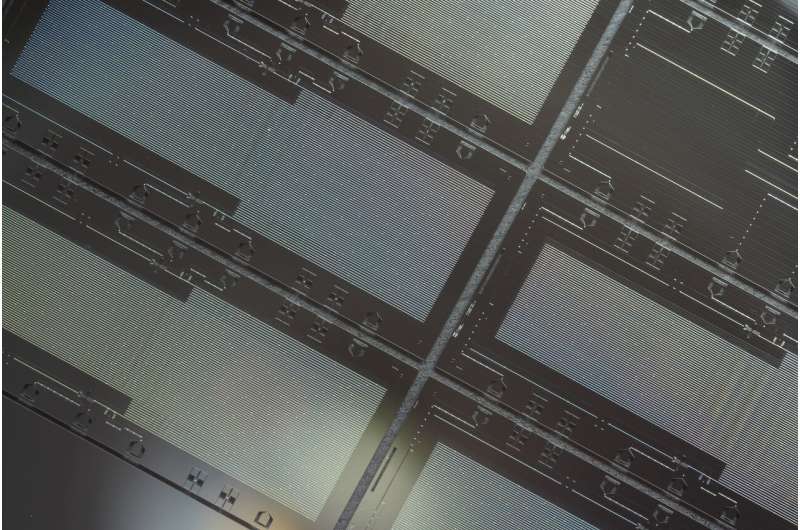Credit: Youpeng Zhong (2019).
The efficient generation of entanglement between remote quantum nodes is a crucial step in securing quantum communications. In past research, entanglement has often been achieved using a number of different probabilistic schemes.
Recently, some studies have also offered demonstrations of deterministic remote entanglement using approaches based on superconducting qubits. Nonetheless, the deterministic violation of Bell's inequality (a strong measure of quantum correlation) in a superconducting quantum communication architecture has so far never been demonstrated.
A team of researchers based at the University of Chicago has recently demonstrated a violation of Bell's inequality using remotely connected superconducting qubits. Their paper, published in Nature Physics, introduces a simple and yet robust architecture for achieving this benchmark result in a superconducting system.
"There is a lot of interest and activity in developing experimental systems where quantum mechanics can be used for information processing (e.g. communication, computation, etc.) and sensing," Andrew Cleland, one of the researchers who carried out the study, told Phys.org. "The heart of a quantum information system is a qubit, and uniqueness comes from the quantum states you can store in it, as well as the more complex quantum states you can store using multiple qubits. We were interested in exploring the transmission of quantum information and quantum states—the fundamentals for quantum communication."
Quantum states, as well as the information that is stored within them, are incredibly delicate, far more than classical states and classically stored information. Although theoretically, there are ways to correct errors in a quantum state, one can typically fix only small errors; hence, the communication of a quantum state needs to be done with very high precision. The high fidelity transmission of a quantum state has so far been achieved using a limited number of methods.
"We wanted to see if we could use some of the best qubits that are available, superconducting qubits, and the best tools for coupling superconducting qubits to communication (transmission) lines, to show we could transmit quantum states with very high precision (i.e. fidelity)," Cleland said.
In quantum physics, the 'gold standard' for testing a certain class of quantum states is Bell's inequality. Essentially, a specific set of measurements of a property of a quantum state (usually written as "S") can exceed a classically limited value of two only if the quantum state is prepared, communicated and measured with high levels of precision.
"Errors made in preparing, transmitting or measuring the quantum state will tend to make the state more classical, and make it harder to exceed the classical limit of two," Cleland explained. "Exceeding this limit is called a violation of a Bell inequality, and is a proof of 'quantum-ness'. This was the measure we set out to achieve, by measuring S for a quantum state using a very precise generation, transmission, and capture of quantum information between two qubits. Happily, we were able to do this."
In their experiment, Cleland and his colleagues used two superconducting qubits connected to one another via an approximately 1-meter-long transmission line. The quantum information was transmitted along this line using microwaves (similar to radio signals), with a frequency similar to that cell phones use to communicate.
"Very importantly, we also had electrically controlled 'couplers' between each qubit and the line," Cleland said. "These couplers are very important, because they allow us to control the coupling of the qubits to the line very rapidly, using classical electrical signals."
These electrically controlled couplers are a key component of the researchers' experiment, as they allowed them to 'shape' the coupling in time very precisely. These couplers ensured that the microwaves carrying the quantum information were transmitted between the two qubits in precisely the right way. This ultimately made sure that the quantum information was sent and received with minimal errors.
"Our experiment shows that very precise quantum information can be sent along a communication path that is quite long, in our case nearly one meter in length," Cleland explained. "The method we used would work with any length line. This demonstrates that the theoretical methods that had been worked out for this nearly error-free transmission are correct, and holds great promise for future quantum communication systems."
The study carried out by Cleland and his colleagues introduced a simple but effective method to achieve a violation in Bell's inequality using remote superconducting qubits. However, as the qubits used in their experiment communicate with microwaves, their method only works at very low temperatures. To communicate quantum information through air, the researchers would need to develop new techniques that can attain similar results using infrared or visible light.
"We are now planning on doing more complex versions of this experiment, using more qubits and more transmission lines, to test out more advanced theories for quantum communication and quantum error correction," Cleland said. "We are also developing methods to try to do the same thing with infrared light, so the signals can be sent through an optical fiber, or through space."
More information: Y. P. Zhong et al. Violating Bell's inequality with remotely connected superconducting qubits, Nature Physics (2019). DOI: 10.1038/s41567-019-0507-7
Journal information: Nature Physics
© 2019 Science X Network























